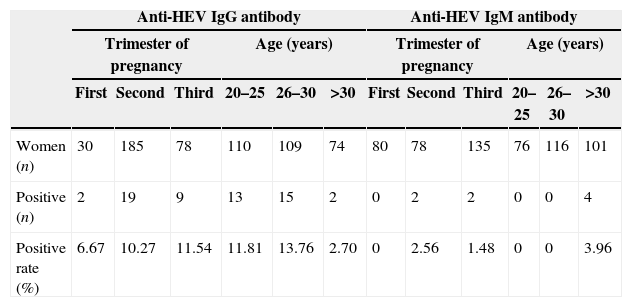Hepatitis E virus (HEV) is an important global public health concern, with particularly high mortality in pregnant women.1,2 HEV is highly endemic in China,3 but epidemiological data for HEV among pregnant women are lacking. In the present study, a serosurvey of HEV among pregnant women in Yunnan, China was conducted. Results revealed a low prevalence of HEV infection in pregnant women.
Serum samples from 293 pregnant women (asymptomatic, apparently healthy), 20–41 years old (mean±S.D.=27.9±3.9) at 7–37 weeks of pregnancy, were collected. HEV RNA was detected by reverse transcription-nested PCR (RT-nPCR) according to the protocol of previous study,4 but we failed to detect RNA in some subjects.
Thirty serum samples (30/293, 10.24%) were positive for HEV IgG by enzyme-link immunosorbent assay (ELISA). The seropositivity of HEV in Yunnan was lower than that in the neighboring provinces, general population of Guizhou (35.7%)5 or people who keep pigs in Southern China (43%).3 Pregnant women aged 26–30 years had the highest positive rate (13.76%), but there was no correlation between increasing age and HEV seropositivity (p=0.169). The seroprevalence in their third trimester was the highest (11.54%, Table 1), although not statistically significant (p=0.803). In these HEV IgG positive pregnant women, 63.33% were in their second trimester of pregnancy. Four women (4/293, 1.37%) were positive to HEV IgM, all older than 30 years and in their second or third trimester of pregnancy (Table 1). IgM antibody emerged during the acute stage of HEV infection, which is very dangerous considering the extremely high mortality rate during their second or third trimester of pregnancy.2,6 Interesting, all the pregnant women were asymptomatic with normal liver enzymes.
Prevalence of anti-HEV IgG and IgM antibodies in pregnant women in Kunming city.
| Anti-HEV IgG antibody | Anti-HEV IgM antibody | |||||||||||
|---|---|---|---|---|---|---|---|---|---|---|---|---|
| Trimester of pregnancy | Age (years) | Trimester of pregnancy | Age (years) | |||||||||
| First | Second | Third | 20–25 | 26–30 | >30 | First | Second | Third | 20–25 | 26–30 | >30 | |
| Women (n) | 30 | 185 | 78 | 110 | 109 | 74 | 80 | 78 | 135 | 76 | 116 | 101 |
| Positive (n) | 2 | 19 | 9 | 13 | 15 | 2 | 0 | 2 | 2 | 0 | 0 | 4 |
| Positive rate (%) | 6.67 | 10.27 | 11.54 | 11.81 | 13.76 | 2.70 | 0 | 2.56 | 1.48 | 0 | 0 | 3.96 |
Although the pregnant women were asymptomatic, it indicated that the HEV circulates at low but significant levels. All patients were living in urban settings, but poor hygienic measures and public health conditions could not be excluded in Yunnan, where raw pork is consumed frequently during Spring Festival. Pregnant women in endemic areas in Yunnan need to be screened for HEV infection during their second or third trimester of pregnancy to decrease the high mortality.
Conflicts of interestThe authors declare no conflicts of interest.
This work was supported by Natural Science Foundation of Yunnan Province in China (Grant No. 2011FZ068) and Foundation of Yunnan Educational Committee, under Grant No. 2011Y382.





